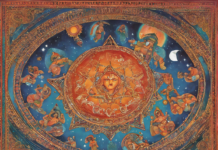The Bhagavad Gita, often referred to as the Gita, is a 700-verse Hindu scripture that is part of the Indian epic Mahabharata. It consists of a conversation between Prince Arjuna and the god Krishna, who serves as his charioteer. The dialogue takes place on the battlefield just before the Kurukshetra War, where Arjuna is filled with doubt and moral dilemma about fighting in the war.
The Philosophy of the Bhagavad Gita
The Bhagavad Gita addresses the concepts of duty, righteousness, and the path to spiritual realization. It delves into various aspects of human life and provides guidance on how to navigate the challenges and complexities of existence. The central theme revolves around the concept of dharma, which refers to one’s duty or righteous path in life.
Key Teachings of the Bhagavad Gita
-
Detachment: The Gita emphasizes the importance of performing one’s duties without being attached to the results. It teaches that focusing on the action itself, rather than the outcome, leads to a sense of inner peace and fulfillment.
-
Self-Realization: The Gita explores the nature of the self and the ultimate goal of realizing one’s true identity beyond the physical body and ego. It advocates for self-awareness and self-discovery as essential components of spiritual growth.
-
Equality: The Gita underscores the principle of equality, teaching that all beings are interconnected and deserve respect and compassion. It promotes a sense of unity and oneness that transcends social, cultural, and religious boundaries.
-
Yoga: The term “yoga” in the Bhagavad Gita refers to the path of spiritual discipline and self-realization. It encompasses various practices, including Karma Yoga (the yoga of selfless action), Bhakti Yoga (the yoga of devotion), and Jnana Yoga (the yoga of knowledge).
Relevance of the Bhagavad Gita Today
Despite being thousands of years old, the teachings of the Bhagavad Gita remain highly relevant in the modern world. In a time of rapid change and uncertainty, the Gita offers timeless wisdom and practical guidance on how to lead a meaningful and purposeful life. Its emphasis on ethical conduct, self-awareness, and spiritual growth resonates with people from all walks of life.
FAQs on the Bhagavad Gita
- What is the significance of the Bhagavad Gita in Hinduism?
The Bhagavad Gita is considered one of the most important texts in Hindu philosophy and spirituality. It offers profound insights into the nature of existence and the path to self-realization.
- Can people of other religions benefit from reading the Bhagavad Gita?
Yes, the teachings of the Bhagavad Gita are universal and can be appreciated by individuals of all faiths. The principles of duty, righteousness, and selflessness are applicable to people from diverse cultural and religious backgrounds.
- How can one practice the teachings of the Bhagavad Gita in everyday life?
By embodying the values of selflessness, detachment, and self-awareness, one can integrate the teachings of the Gita into their daily activities. Practicing mindfulness, cultivating a spirit of service, and seeking self-improvement are ways to align with the Gita’s teachings.
- What is the role of karma in the Bhagavad Gita?
Karma, or the law of cause and effect, plays a central role in the Bhagavad Gita. The text emphasizes the importance of performing one’s duties selflessly and accepting the outcomes, recognizing that every action has consequences.
- How does the Bhagavad Gita address the concept of suffering?
The Gita acknowledges the reality of suffering and challenges in life but offers a perspective shift by advocating for resilience, inner strength, and spiritual awareness as keys to overcoming adversity.
In conclusion, the Bhagavad Gita stands as a beacon of spiritual wisdom and philosophical insight that continues to inspire and guide seekers on the path to self-discovery and enlightenment. Its timeless teachings provide solace, clarity, and direction in the journey of life, offering profound lessons that resonate across cultures and generations.








